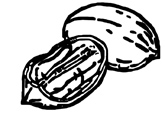
- Pollination Type
- Scab Resistance
- Alternate Bearing
- Precocity
- Harvest Date
- Nut Size and Quality
- Characteristics of Pecan Cultivars Recommended for Georgia
- Photos of Varieties
Establishing a new orchard or renovating an older orchard is an exciting time for a pecan grower because it provides an opportunity to significantly improve the productivity of the farm. However, choosing which cultivars to plant can be one of the most difficult decisions a grower has to make. Pecan cultivars vary widely in yield potential, nut quality, date of maturity, tree form and resistance to insects and diseases. Problems encountered due to a poor choice in cultivars can be difficult or impossible to correct through cultural methods, and may lead to the time and expense of re-planting. It is vital that new cultivars be chosen with care since a productive pecan orchard can last for generations.
Growers naturally want to know what the “best” variety is to plant. Blanket recommendations should not be made because every orchard situation is different. What may be the best choice for one orchard may not be the best selection for a different orchard. For example, some orchards are situated in extremely humid sites and have high levels of precipitation, making scab resistance the most important factor in selecting varieties. Other orchards are in drier, more open sites, and scab resistance may be secondary to yield potential. Just as every orchard is different, so are growers and the management strategies they employ. While there is widespread consensus that a good cultivar will be a productive, disease- and insect-resistant tree producing large, high-quality nuts early in the harvest season, this cultivar does not yet exist. Each variety has its own strengths and weaknesses and may or may not be suitable depending upon orchard characteristics. A grower must decide which factors are most important to his situation and make selections accordingly.
Regardless of the care taken in choosing an appropriate variety, experience has taught growers that any variety may in time fail to be as well adapted as it first appeared. Among the most important factors to consider when selecting a variety are pollination type, disease resistance, alternate bearing potential, precocity (the bearing age of the tree), harvest date, pollination type, nut size and nut quality.
Pollination Type
Pecan trees produce separate male (catkins) and female (nut cluster) flowers on the same tree. Basic flowering timing follows one of two patterns. Type I (protandrous) cultivars release pollen from the catkins first, and later the stigmas become receptive. Type II (protogynous) cultivars have stigmas that become receptive first and the pollen is shed after the flowers have been fertilized. In natural pecan stands about one half of the trees will be Type I and the other half Type II. Flowering timing is also influenced by when the trees leaf out in the spring. Those varieties that leaf out sooner generally will flower sooner. Thus, a Type I tree that leafs out quickly will shed pollen earlier than a Type I tree that leafs out later. In fact, a very late Type I variety may shed pollen at the same time as an early Type II variety.
Viable pollen must be available for the female flowers during the receptive period in order for a particular tree to set a crop. Self-pollination seldom produces large crops and leads to poor nut growth and development, resulting in low nut quality. Therefore, it is recommended that a combination of compatible varieties be planted to ensure pollen release throughout the pollination period. This can best be accomplished by planting at least two “pollinator varieties” in the orchard. In commercial orchards a grower must be careful to plant a combination of cultivars that will ensure adequate pollination. The pollination chart listed in Table 1 will assist growers in selecting a mixture of cultivars that pollinate each other.
Research indicates that effective pollination may decrease at distances greater than 150 feet from a pollen source. A general rule of thumb is that pollinators should be no more than three rows apart. Pollinator varieties with similar nut and kernel characteristics to main varieties can be positioned within main variety rows or can be blocked in rows. An effective alternative to blocking varieties is to place a pollinator at every fifth tree within every fifth row. This will provide adequate pollination and the amount of pollinator nuts will be small enough that the crop will not bring lower “blended” prices.
Scab Resistance
Pecan scab is by far the most serious challenge facing pecan production in Georgia. Our warm, humid climate is ideally suited to the pecan scab fungus, which can devastate susceptible varieties when environmental conditions are favorable to the fungus. Some orchards may require up to 15 fungicide applications in a season, and many varieties are too scab susceptible to be recommended even with fungicide control.
The scab fungus travels relatively slowly from one region to the next. A particular variety may seem scab resistant in one location and be very susceptible elsewhere. Research has shown that the scab fungus is composed of multiple races, each suited to grow best on a small number of varieties. Therefore, the resistance level of a particular variety will be influenced by what races are present in the orchard in which it is grown. For example, an orchard composed largely of 'Desirable' trees will probably have a large proportion of scab fungus that is suited to grow on 'Desirable' trees. If a few trees of 'Sumner' are planted in this orchard, 'Sumner' may not at first be much affected by scab. This is because a majority of spores that land on 'Sumner' trees are from 'Desirable' trees and are not suited to growing on 'Sumner' leaves. However, the few spores that grow successfully on 'Sumner' will reproduce and over time scab may become more of a problem. The greater the number of 'Sumner' trees that are planted, the more quickly this may occur. This leads to the cycle we commonly see where new cultivars start out appearing highly resistant, but over time appear more and more susceptible.
'Desirable' is an example of a variety that once had good levels of resistance but that is now very susceptible. The variety itself is not changing; rather, the pathogen is adapting to the variety. On the other hand, a few varieties like 'Elliott' have had excellent levels of resistance for many years. Currently it is not possible to predict how a variety's resistance will hold up over time.
Alternate Bearing
Alternate bearing is a serious problem in pecan production. Alternate bearing refers to the tendency for the pecan tree to produce many nuts of poor quality in one crop year, followed by a year in which the tree bears a very light crop. Alternate bearing appears to be controlled by two mechanisms. Growth regulators produced by the developing nuts repress the induction of flower buds for the next season's bloom. Secondly, excessive crop loads can leave trees depleted of stored carbohydrates so that flower buds are aborted the following spring.
Alternate bearing significantly affects pecan marketing and the price the grower obtains for his crop. While all pecan trees have a tendency to bear alternately, some varieties are much better at producing regular crops than others. More pecan varieties have probably been eliminated from Georgia orchards because of their tendency to alternate bear than for any other reason except scab susceptibility. Therefore, much thought should be given to the alternate bearing tendency of a particular variety before planting.
The alternate bearing index (I) is a measure of a cultivar's tendency to produce alternating high and low yields. This can be a valuable tool when making comparisons of varieties. Ranges are from 0 to 1, with 0 = no alternation and 1 = complete alternation, which would be no yield every other year. The producer can temper the alternate bearing of some varieties with proper management of the crop load and fertility as discussed in the corresponding sections of this publication.
Precocity
Precocity is the ability of a particular variety to begin bearing nuts at an early age. A precocious variety like 'Cape Fear' can be of benefit in that the producer can begin to harvest a marketable yield at an earlier point in the life of the orchard than he can with other less precocious varieties. Unfortunately, precocity is often associated with excessive fruiting or overloading, resulting in poor quality as the tree becomes mature. Again, growers should not let the overloading tendency alone determine their variety choices because there are management tools available that can help reduce the impact of this problem.
Harvest Date
Pecans are traditionally marketed and used during the Thanksgiving and Christmas holiday seasons. As a result, early harvest is required to supply nuts for the holiday market. Early-maturing varieties usually bring higher prices than later-maturing varieties, although this is not always the case. For example, 'Sumner', a late-maturing variety, can often bring a better price than that obtained from poor quality early-maturing varieties.
Early nut maturity will often allow nuts to be harvested under favorable conditions of dry weather in the southeastern United States. Cloudy, wet and cool weather can delay harvest and lead to a deterioration of nut quality. Growers should only plant very early maturing cultivars like 'Pawnee' if they are able to harvest them promptly, otherwise bird and squirrel depredation can be severe.
Nut Size and Quality
Nut size is a dominant factor in the selection of a variety and can be important for several reasons: consumers tend to prefer large pecans; large pecans can be marketed in or out of the shell; a large nut is more economical to shell; and, most importantly, large pecan halves generally sell at a higher price than smaller halves. The disadvantage of a large nut is that it is more difficult to fill and consistently obtain good quality kernels. Nut size is normally measured as the number of nuts per pound. In general, the larger the nut, the fewer nuts per pound. Each variety has a characteristic nut count, with a count of 40 to 50 nuts per pound being ideal.
Nut quality is determined primarily by the percent kernel. Percent kernel is the proportion of the nut that is kernel or meat. Percent kernel varies with soil moisture and crop load; however, each variety has a characteristic kernel percentage. Typically, most cultivars show a drop in percent kernel as the trees age. This is because young trees are producing relatively light crops and have more than enough leaves to support the developing kernels. However, as the trees mature, they set heavier crops and become limited in their ability to fill all the nuts.
Table 1 lists the recommended commercial pecan varieties for Georgia along with various characteristics of each that may aid in the grower's decision-making process. When choosing a variety, growers should bear in mind that there is no single best variety. All selections have both weak and strong points. The key is to find a variety that will best suit your particular orchard situation.
| Table 1. Characteristics of Pecan Cultivars Recommended for Georgia | |||||||
| Cultivar | Parentage |
Dichogamy2
|
Nuts Per
Pound3 |
Percent
Kernel3 |
Scab4
|
Nut Maturity3
|
I5
|
|
Cultivars Recommended for Georgia1
|
|||||||
| Caddo | Brooks x Alley |
I
|
67
|
54
|
3
|
Oct. 11
|
0.32
|
| Desirable | Success x Jewett |
I
|
48
|
51
|
4
|
Oct. 14
|
0.40
|
| Elliott | Seedling |
II
|
77
|
51
|
1
|
Oct. 12
|
0.68
|
| Forkert | Success x Schley |
II
|
53
|
58
|
3
|
Oct. 19
|
0.53
|
| Kanza | Major x Shoshoni |
II
|
74
|
52
|
1
|
Sept. 20
|
0.72
|
| Oconee | Schley x Barton |
I
|
48
|
53
|
3
|
Oct. 12
|
0.37
|
| Pawnee | Mohawk x Starking HG |
I
|
56
|
54
|
4
|
Sept. 17
|
0.61
|
| Sumner | Schley Seedling |
II
|
56
|
49
|
2
|
Oct. 29
|
0.56
|
|
Cultivars Recommended for Trial1
|
|||||||
| Amling | Seedling |
I
|
57
|
55
|
1
|
Oct. 17
|
UK
|
| Byrd | Wichita x Pawnee |
I
|
50
|
59
|
2
|
Sept. 22
|
UK
|
| McMillan | Seedling |
II
|
51
|
50
|
1
|
Oct. 12
|
UK
|
| Excel | Seedling |
II
|
44
|
49
|
1
|
Oct. 13
|
UK
|
| Lakota | Mahan x Major |
II
|
59
|
61
|
1
|
UK
|
UK
|
| Mandan | BW-1 x Osage |
I
|
49
|
57
|
2
|
Sept. 21
|
UK
|
| Zinner | Seedling |
II
|
48
|
56
|
3
|
Oct. 12
|
UK
|
|
Cultivars That Have Merit in Some Situations1
|
|||||||
| Cape Fear | Schley Seedling |
I
|
55
|
51
|
2
|
Oct. 19
|
0.41
|
| Creek | Mohawk x Starking HG |
I
|
55
|
48
|
2
|
Oct. 18
|
0.68
|
| Kiowa | Mahan x Desirable |
II
|
48
|
53
|
3
|
Oct. 21
|
0.65
|
| Stuart | Seedling |
II
|
55
|
46
|
3
|
Oct. 15
|
0.47
|
| 1 Cultivars in the top of the table are recommended generally; those recommended for trial have looked good so far but are new and data is limited; and those in the bottom are recommended for special situations. All pecan cultivars have strengths and weaknesses and growers should consult other experienced growers, Extension agents and specialists when determining which cultivar to plant. 2 Type I = protandrous (pollen shed first); Type II = protogynous (stigma receptive first). 3 Average from Tifton, Ga. cultivar trials. 4 1 = excellent resistance, 2 = good resistance, 3 = mediocre resistance, 4 = poor resistance. 5 I = Alternate bearing index. Ranges are from 0 to 1, with 0 = no alternation and 1 = complete alternation, which would be no yield every other year. UK = Unknown |
|||||||
Photos of Varieties
Amling
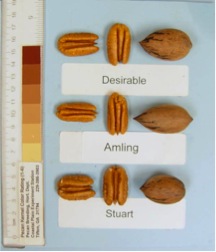 Amling
AmlingSo far, this selection has beautiful dark green foliage and excellent resistance to most pests. The medium-sized nuts have a high quality kernel and are easy to shell. Although this cultivar is considered by some to have low yield potential, it is too early to tell in our trees at this point. This appears to be a good cultivar for a yard tree as the nuts are high quality and pest problems are few. It would also be well suited to organic or low-input applications. A limitation to this cultivar is that it has only medium-sized nuts.
Byrd
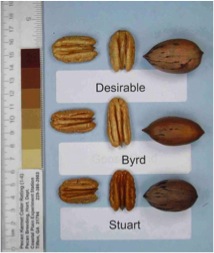 Byrd
ByrdThis cultivar is the first to be released from the breeding program initiated in 1989 by UGA professor Darrell Sparks. 'Byrd' was selected from a cross of 'Pawnee' x 'Wichita'. It is one of the very few cultivars with a large size and very early harvest date, usually ripening in mid-late September, about a week after 'Pawnee'. It appears to have an advantage over 'Pawnee' in that it is less scab susceptible; however, this is a new cultivar and scab may become an issue in the future. Growers should plant this cultivar with the thought that it will require full season fungicide protection to control scab. This is a precocious variety that will need fruit thinning as the tree matures. 'Byrd' trees have a large cluster size and load up with nuts. This will be a recipe for strong alternation if crop load is not managed by shaking them off in the summer. Nut size and quality have been very good. Shell thickness is very thin and kernels are well developed, leading to a high percent kernel.
Caddo
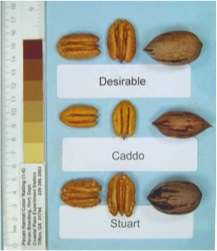 Caddo
CaddoIn terms of yield potential, 'Caddo' is one of the best varieties we have tested. 'Caddo' is a precocious cultivar (begins bearing at an early age), and production remains high in mature trees without going into an extreme alternate bearing cycle as most precocious cultivars do. Nut quality in 'Caddo' is quite good at 54 percent kernel, with more than half the kernels rated as fancy. 'Caddo' has a slender kernel with an attractive gold color. Unlike many cultivars, nut quality remains high in mature trees even with the larger yields. 'Caddo' is not without limitations, the greatest being that it is not a large nut, averaging only 67 nuts per pound. 'Caddo' is an early-ripening pecan, with an average harvest date of October 11. 'Caddo' is scab susceptible, but we have been able to control scab with a standard spray program. We have noticed that 'Caddo', much like 'Sumner' and 'Gloria Grande', appears to be favored by black aphids and should be monitored for this pest. We recommend 'Caddo' as a consistent producer of good quality kernels of medium size.
Cape Fear
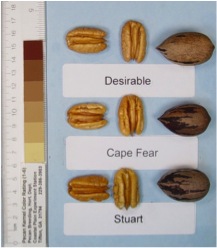 Cape Fear
Cape Fear'Cape Fear' is a precocious cultivar that produces well-filled nuts with attractive golden kernels as a young tree. However, percent kernel often drops in mature trees because they tend to overload and go into an alternate bearing cycle. A strong plus for 'Cape Fear' is good resistance to pecan scab in most locations. However, in some orchards 'Cape Fear' scabs nearly as badly as 'Desirable', so the 'Cape Fear' variety's resistance has been overcome in some orchards. This cultivar seems to be more susceptible to infection with bacterial leaf scorch, which can cause premature defoliation and further exacerbate alternate bearing problems. 'Cape Fear' should be considered by growers in need of a more scab-resistant cultivar and who are willing to manage crop load.
Creek
 Creek
Creek'Creek' was released primarily for its superior precocity and disease resistance. In Tifton tests, 'Creek' began bearing quickly, but actual kernel yield was only average. Productivity as a mature tree was similar to the other cultivars, with a tendency to bear alternately. Nut size was good at 55 nuts per pound, but quality was often poor with percent kernel averaging only 48 percent. 'Creek' only produced a small percentage of kernels rated fancy due to a tendency to be poorly filled. 'Creek' kernels also often have an unattractive wrinkling of the seed coat at the apex of the kernel. 'Creek' was released as a highly productive temporary tree that could be removed as the orchard matured. 'Creek' may be suitable under some high-density situations where the crop load is thinned, but we do not recommend it for standard orchard conditions. 'Creek' is reported to set good crops on shaded limbs, a desirable trait for high-density plantings. Pest resistance of 'Creek' is good, and it tends to be an “easy keeper” for most disease and insect problems. Harvest date is usually earlier than what we saw in our test orchards, probably early October, which allows it to be sold for a better price than would normally be obtained for a nut of mediocre quality.
Desirable
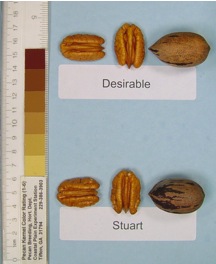 Desirable
Desirable'Desirable' is a well-known cultivar that sets the standard for quality in the Southeast. Large, well-filled nuts produce excellent kernels and bring top price on the market. It is an excellent sheller producing many mammoth halves. Perhaps its strongest feature is the ability to produce consistent high-quality crops year to year. 'Desirable' tends to thin its own clusters to two to three nuts each, thus lowering the stress on the tree and reducing alternate bearing. In most commercial orchards in Georgia, 'Desirable' is the main cultivar. However, 'Desirable' is not without its faults. This cultivar is probably the most scab-susceptible cultivar that can still be grown in the Southeast. Scab control will take a full season of fungicide protection, and control may still be difficult in high-pressure environments. 'Desirable' trees are somewhat slow growing and are more difficult than other cultivars to prune into strong trees.
Elliott
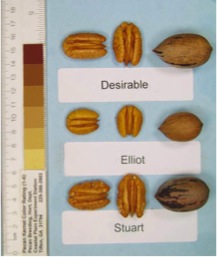 Elliott
Elliott'Elliott' is widely planted in Georgia. Its resistance to scab and excellent quality nuts were responsible for the University of Georgia Cooperative Extension recommending it for orchard planting in the early 1960s. We still recommend it for growers looking for a cultivar that needs little or no scab protection. 'Elliott' has a small, teardrop-shaped nut of extremely high quality. Growers should receive a premium price for a small nut because of its plump, perfect halves. Percentage fill and specific gravity are high. It bears alternately, but nut quality remains high in the ON years. Growers should seek those specialty markets that are aware of the merits of this cultivar, otherwise it might bring seedling prices. High scab resistance makes it a good choice for home orchard plantings. 'Elliott' is susceptible to late spring freezes and should not be planted in north Georgia or in low spots. For these areas, we recommend 'Kanza' instead. Yellow aphids can be a problem with this cultivar, and young trees are slow to come into production.
Excel
 Excel
Excel'Excel' was discovered as a seedling tree on a pecan farm near Blackshear, Ga. It was patented and disseminated by Andy Clough, who operates a nursery on his farm. We began testing this selection in 2002 and the trees have not yet begun to fruit. The following information is from observation of trees in Blackshear, Ga. Nut size is large and similar to 'Desirable'. The shell is thick, like 'Gloria Grande', and the kernel has a bright golden color with an attractive shape. Kernel color holds very well in storage. The kernel is packed fairly tightly in the shell, making it more difficult to shell out.
We recommend this cultivar for trial because it is one of the few cultivars with large nut size and high resistance or immunity to scab. However, this is a new cultivar, and often once new cultivars are widely planted scab resistance breaks down because new races of the pathogen develop the ability to infect the cultivar. So far, scab has not yet been reported on this cultivar with fairly wide plantings having been made. A thick shell limits the percent kernel to somewhere around 51 percent with excellent fill. Nut quality has been marginal due to low kernel percentage (49 percent), but most trees are young so it is difficult to assess what the quality of mature trees will be. Cluster size and nut size are large, suggesting that nut thinning may be necessary in mature trees. Tree limbs are relatively thin, producing a willowy growth that may make it difficult to mechanically thin the crop. The canopy is sparse, and it is usually one of the latest trees to leaf out in the spring. Right now we recommend this cultivar for trial, especially where high levels of scab resistance are being sought.
Forkert
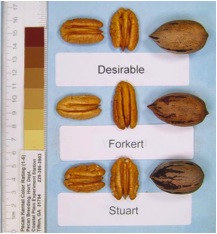 Forkert
ForkertThe outstanding feature of 'Forkert' is nut quality. In the Tifton, Ga., cultivar tests 'Forkert' averaged 58 percent kernel over all the years, with more than half of the kernels rated as fancy. 'Forkert' is a large nut at 53 nuts per pound, with a rather bumpy thin shell. 'Forkert' kernels are smooth, attractive and shell out well. The biggest drawback to 'Forkert' kernels is tight dorsal and ventral grooves that sometimes allow the packing material to stick in the kernel. 'Forkert' is a favorite for the in-shell market because the thin shell is easy to crack and the kernel is large and attractive. Harvest date for 'Forkert' averaged around October 19, about the same time as 'Stuart'. 'Forkert' is susceptible to scab, which has been easily controlled with a standard spray program in our orchard. 'Forkert' is another cultivar that must be monitored for black aphid buildups. 'Forkert' is recommended as a producer of large, high-quality nuts that are especially suitable for the in-shell market.
Kanza
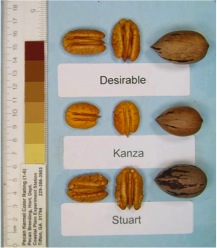 Kanza
Kanza'Kanza' was released by the USDA because of its superior productivity, quality, disease resistance and cold tolerance. 'Kanza' has good productivity as a mature tree. Alternate bearing has been a problem with 'Kanza', but nut quality in high production years is good. Harvest date is early, averaging around October 8 or the end of September. 'Kanza' produces a small, attractive, round kernel. The nuts are so similar to 'Elliott' that they can be hard to differentiate. 'Kanza' was primarily released for use in the northern pecan growing regions due to its excellent cold hardiness. Its early maturity and small size makes it susceptible to predator damage when only a few trees are planted. So far, 'Kanza' appears to have excellent resistance to scab, but it has not been widely grown in Southern orchards so it is unknown how this resistance will hold up in the long run. We recommend 'Kanza' as a replacement for 'Elliott' in northern areas where 'Elliott' would be damaged by late spring freezes. In southern areas we continue to recommend 'Elliott' because of its proven track record of high scab resistance.
Kiowa
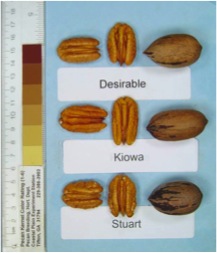 Kiowa
Kiowa'Kiowa' is a precocious cultivar that begins to bear alternately as a mature tree. Nut size is slightly larger than 'Desirable'. Quality in most years is good; however, in years with a high crop load, quality will suffer. Mechanical shaking during years of excessive nut set would help alleviate this problem, but the nuts are strongly attached to the stem and shaking them off is reported to be difficult. Kernel color is slightly dark, and not as light and attractive as 'Desirable'. Scab resistance in 'Kiowa' is variable, with some locations reporting very good resistance and other locations reporting susceptibility similar to 'Desirable'. The 'Kiowa' variety's advantage over 'Desirable' is that it will yield heavier than 'Desirable' as a young tree and is much easier to train into a central leader. In some locations, it may also be easier to control scab on 'Kiowa'. The disadvantage of 'Kiowa' in comparison to 'Desirable' is that it tends to overbear as a mature tree, and it can be difficult to maintain a high-quality kernel in overbearing years due to its large size. We do not normally recommend 'Kiowa'; however, it can be a good cultivar in the right situation.
Lakota
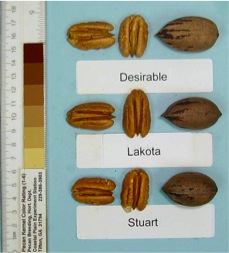 Lakota
Lakota'Lakota' was released in 2007 by the USDA for all growing regions, but was not trialed in the Southeast. We planted six trees in the Ponder Variety Trial in 2009. 'Lakota' is promising because of its high levels of scab resistance and early harvest date (about two weeks after 'Pawnee'). Some growers in Oklahoma have felt that the quality of this nut is not always what they desire. Growers should only plant small blocks of this cultivar until it has been tested further.
Mandan
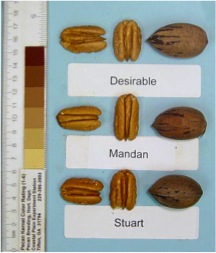 Mandan
Mandan'Mandan' was released by the USDA in 2009 for all growing regions. We have tested a few trees for only a couple of years, so our information is preliminary. 'Mandan' is one of three cultivars ('Mandan','Byrd', 'Pawnee') that produce a large nut harvestable in mid- to late September. In Tifton, Ga., 'Mandan' ripens about a week after 'Pawnee' and about the same time as 'Byrd'. At this point, 'Pawnee' scabs more than either 'Byrd' or 'Mandan'. The quality of 'Byrd' appears better than that of 'Mandan', but 'Mandan' sets a more sustainable crop and is in less need of crop thinning. Until we have more data in the Southeast, only trial blocks should be planted to 'Mandan'.
McMillan
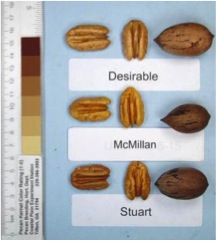 McMillan
McMillanThis cultivar comes to us with a reputation of being a consistent bearer of mid-size nuts with excellent scab resistance. 'McMillan' was planted in our orchards in 2002 and bore its first crop in 2005. So far, we have not observed scab on our trees in a sprayed orchard. This has been a high-yielding precocious cultivar. Nut quality is only average, with a thick shell reducing percent kernel to about 50 percent, and kernel color being a little dark. While the nut quality is not too exciting, the productivity and scab resistance of this cultivar suggest it as a good choice for low-input plantings. Standard commercial growers will probably want a higher quality nut that might demand a higher price.
Oconee
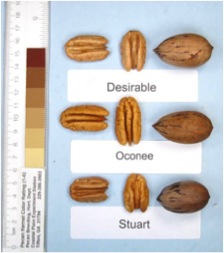 Oconee
Oconee'Oconee' features an attractive mix of large nut size and high kernel quality. 'Oconee' is an excellent sheller, producing a large percentage of intact halves. 'Oconee' is not as precocious as 'Caddo' or 'Cape Fear', but has higher early yields than non-precocious cultivars like 'Gloria Grande' and 'Forkert'. This higher early kernel production is due in part to the very high percentage kernel of these early crops. Yields of mature trees have been average, and we noticed in our orchard that performance of 'Oconee' seemed to decline when the trees began to shade each other; therefore 'Oconee' orchards may need to be thinned promptly. 'Oconee' has an early harvest date, averaging around October 12. This, in combination with its large size and attractive kernels, should make 'Oconee' a profitable cultivar. 'Oconee' is scab susceptible and will need a good spray program to control this disease. 'Oconee' is a preferred cultivar for black aphids and will need to be treated to prevent severe damage from this pest.
Pawnee
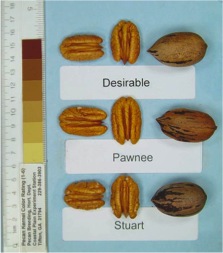 Pawnee
PawneeThe most outstanding feature of 'Pawnee' is its large nut size combined with very early nut maturity. No other large pecan can compete with 'Pawnee' on the early market, providing a substantial price benefit in most years. Yields from 'Pawnee' have been average as a young tree, but as a mature tree 'Pawnee' was a top producer of usable kernels. 'Pawnee' does tend to bear alternately, and mature trees will benefit from mechanically shaking off excess crop, especially if trees are crowded.
'Pawnee' produces a high-quality nut of medium to large size. 'Pawnee' produces a light colored kernel with excellent quality. However, color darkens quickly in storage, and the kernel can become stained if the nuts are rained on after shaking the trees, necessitating a prompt harvest to retain maximum quality. 'Pawnee' kernels sometimes show a speckling on the kernel surface, which may limit the 'Pawnee' variety's usefulness in the giftpack trade. Scab susceptibility is serious problem. In 2004 and 2005, 'Pawnee' trees planted in Tifton showed more nut scab damage than the 'Desirable' trees planted next to them. In fact, in 2005 the 'Pawnee' crop was severely damaged due to scab despite a full-season fungicide program. We do not recommend 'Pawnee' be planted in areas where scab control is likely to be a major concern.
Stuart
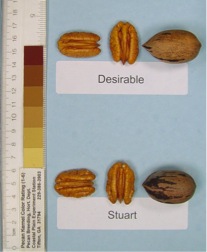 Stuart
StuartThe 'Stuart' pecan is well known in Georgia, and this cultivar was instrumental in forming the Georgia pecan industry. 'Stuart' produces a large nut that matures early in the season. Mature 'Stuart' trees can be very productive and are often a profitable core of the orchard. However, 'Stuart' has some important drawbacks that limit its usefulness in new plantings. 'Stuart' takes a long time to come into production, especially in comparison to most newer cultivars. In addition, the nut quality can be marginal in many years. We have trouble with this cultivar not filling well, and in those cases the kernel is often dry with a fair amount of fuzz adhering to the surface. Yellow aphids like this cultivar. If they are not controlled, the honeydew builds up on leaf surfaces and leads to sooty mold, which seems to adhere particularly well on 'Stuart' leaves. 'Stuart' is scab susceptible, but it is easier to control than it is on 'Desirable'. An orchard of mature 'Stuart' trees can be very profitable but we hesitate to recommend anyone plant more of this variety.
Sumner
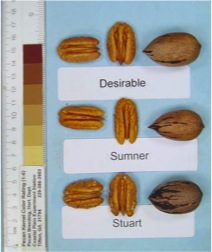 Sumner
Sumner'Sumner' has been included in the Coastal Plain Experimental Orchards since 1940, and was first recommended for Georgia by Ray Worley. Our data indicates that 'Sumner' is not a precocious cultivar and can in fact be somewhat slow to come into bearing. Mature tree production was about average and 'Sumner' has fairly regular production. 'Sumner' produces relatively large nuts of moderate quality. 'Sumner' can overload and alternate and will benefit from crop thinning in some years. Average harvest date is late, October 29, and this is a major disadvantage of this cultivar. 'Sumner' is a favorite cultivar for black pecan aphids and is typically one of the first to show damage from this pest. Historically 'Sumner' has been very resistant to scab, and this is one of the key factors in its widespread use. However, scab susceptibility has been reported recently in some locations. If loss of resistance becomes widespread for this cultivar, the combination of that with its late maturity and susceptibility to black pecan aphids means the appeal of this cultivar would be greatly diminished.
Zinner
 Zinner
Zinner'Zinner' was planted in our orchards in 2002 and bore its first crop in 2005. It produces a good sized nut with a beautiful golden color. Slightly smaller than 'Desirable', it is still a large nut. The shell is thin and the kernels have been very well developed. Yields have been fair, but not great (very similar to 'Stuart') although kernel yield would be much higher than 'Stuart' because the percent kernel is higher. While young trees are quite vigorous, this is not a precocious variety. Scab damage has been light in trial situations with full fungicide protection. This cultivar is a preferred cultivar for black aphids, and damage can be severe if they are not treated. Right now we recommend this cultivar for trial until we know a little more about mature tree productivity.
Status and Revision History
Published on May 26, 2006
Published on Feb 27, 2009
Published with Minor Revisions on Feb 02, 2012
Published with Full Review on Feb 24, 2015


























































